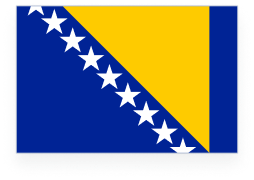2. Sarajevo built an electric tram system before London
![]()
Sarajevo’s electric tram system predates London’s.
Sarajevo is the capital of and largest city in Bosnia Herzegovina. The city has one of Europe’s earliest electric tram systems, founded with horse-drawn trams in 1885.
Ten years later, Sarajevo migrated to electric trams. London adopted electric tram service in 1901.
The tram outlasted World Wars I and II, the Socialist Federal Republic of Yugoslavia era, the Bosnian War, and the 1992–1995 siege of Sarajevo, with its east west line connecting the city center to suburbs.
>> LEARN MORE: FROM LITERAL CROSSROADS TO CULTURAL CROSSROADS IN THE BALKANS
3. Bosnia has a tiny 20km coastline that juts out into Croatia’s Dalmatian beaches
The Ottoman Empire secured Bosnia’s only Adriatic Sea access: a 20-kilometer strip at Neum that divides Croatia’s 1,800-kilometer Dalmatian coastline.
![]()
Bosnia and Herzegovina has a 20-kilometer strip of coastline.
4. One in 50 Bosnians died in Europe’s deadliest conflict since World War II
Bosnian Serb militias along with the Yugoslav People’s Army launched attacks against Bosnian Muslims and Bosnian Croats after Bosnia declared independence from Yugoslavia.
The Bosnian War between 1992 and 1995 was Europe’s deadliest conflict since World War II. 100,000 people died and 2.2 million were displaced.
The war ended with the 1995 Dayton Agreement, a peace agreement that ended the war but didn’t end societal divisions.
The international community created a complicated democracy in the 1995 Dayton Agreement to maintain balance for the different ethnic groups.
Two autonomous entities govern the country: the Federation of Bosnia and Herzegovina controls 51% of territory through 10 local governments, while Republika Srpska governs 49% through a centralized governance system. The neutral Brčko District’s 493 square kilometers operate independently.
Each autonomous region maintains their own local government, including separate parliaments, prime ministers and cabinets.
The Federation elects one Bosniak and one Croat president while the Republika Srpska elects a Serb president. These three co-equal leaders from the three major ethnic groups must achieve consensus or two-thirds majority for major decisions. Each president serves 4 years while rotating chairmanship every 8 months.
![]()
Bosnia and Herzegovina’s tripartite presidency is one of the core fun facts about Bosnia. The leaders since 2022 are: (L-R): Denis Bećirović, Željka Cvijanović, Željko Komšić. (Attributions L-R: Quirinale.it, Attribution, via Wikimedia Commons; © European Union, 2024, CC BY 4.0, via Wikimedia Commons; © European Union, 2024, CC BY 4.0, via Wikimedia Commons)
What is Republika Srpska?
Republika Srpska is a non-continuous region of Bosnia Herzegovina located in the northern and eastern parts of the country. The name means Bosnian Serb Republic. Banja Luka is the capital city.
Political divisions of Bosnia and Herzegovina
Bosnia and Herzegovina’s political divisions were established by the Dayton Agreement. The country is split into two federal entities: the Federation of Bosnia and Herzegovina (FBiH) and Republika Srpska (RS), along with a shared administrative area called the Brčko District.
![]()
A map of Republika Srpska (Andrein, CC BY-SA 4.0, via Wikimedia Commons)
6. The government of Bosnia and Herzegovina is one of the only externally supervised democracies in the world
The Dayton Agreement created the Office of the High Representative (OHR) in Bosnia and Herzegovina to supervise the peace agreement. The OHR can impose laws and remove elected officials to maintain peace and stability in the country.
Bosnia and Herzegovina’s history in a minute
Four empires transformed Bosnia and Herzegovina (and other Western Balkan countries) before Yugoslavia’s creation in 1918.
- The Roman Empire built military stations across Bosnia’s river valleys, building roads that still connect the Adriatic Sea to the Danube.
- Soft influence from the Byzantine Empire spread Orthodox Christianity through the area leading to the construction of basilicas.
- The Medieval Bosnian Kingdom emerged in the Middle Ages, minting its own coins before Ottoman Empire forces conquered Bosnia in 1463, beginning 415 years of Islamic influence.
- The Austria-Hungary Empire annexed Bosnia and Herzegovina in 1878 and brought modernization and industrialization. Learn more fun facts about Austria.
The Yugoslav era could not hold the country together.
- The Kingdom of Yugoslavia unified Bosnia and Herzegovina with Serbs, Croats and Slovenes after World War I, but political instability fueled ethnic tensions and Croatian and Serbian rivalries prevailed.
- World War II saw Bosnia ceded to the Nazi-backed Independent State of Croatia, with atrocities against Serbs, Jews, and others. Josip Broz Tito led a group that resisted Axis forces, restoring Bosnia as a republic within the Yugoslav federation.
- Post War, the Socialist Federal Republic of Yugoslavia ushered in a period of economic prosperity and modernization, with Bosnia becoming an industrial hub and hosting the 1984 Winter Olympics. Nationalist tensions resurfaced in the 1980s, setting the stage for the dissolution of Yugoslavia.
- The Bosnian War erupted after independence in 1992, marked by ethnic cleansing, genocide and the Srebrenica massacre. The Dayton Agreement ended the war in 1995, creating a fragile political framework that persists today.
Post-Bosnian War, Bosnia has struggled with political corruption and economic stagnation. The persistent divisions of an ethnically mixed and divided country remain in place. Today in Bosnia and Herzegovina, the country balances three religions and three official languages amongst its 3.3 million citizens and two autonomous regions.
>>Learn more about Bosnia and Herzegovina



